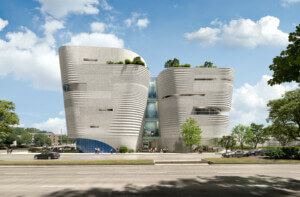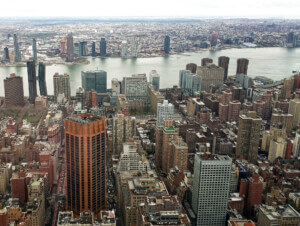Few buildings are tasked with negotiating complexity quite like the embassy. An embassy’s exterior conveys how a country sees itself, while simultaneously telegraphing how it wants the host country to see it. Embassy interiors must then do all that while also managing the tensions between those two views.
So, it’s a strategically designed achievement that the new U.S. embassy in Ankara, Turkey appears so effortless. Ennead Architects has devised a campus that updates the International Style into what might be characteristic, metaphorically, of 21st-century Americana: Its structure seems to endorse transparency without actually offering much of it, and it’s crafted to recognize local architectural traditions yet remains recognizable to anyone familiar with D.C.’s federal white stacks. Interior architecture is by Spacesmith.

“The number one reason [the U.S. is] building new embassies is that many of them were built a hundred years ago in the middle of cities, and they don’t meet the current security requirements—for instance, a 30-meter setback from the street.” Ennead design partner Richard Olcott told AN. Such concerns are why the U.S. left its lovely 1960 Eero Saarinen digs in Grosvenor Square and moved, in 2017, to a glittering KieranTimberlake cube—partially surrounded by a moat—in Nine Elms. Meanwhile, Saarinen’s building is slated to reopen as a hotel in 2025.

In Ankara, Ennead worked with landscape architects at GGN to fill the now-standard setback with local landscaping, but it was a literal uphill battle, as the nine-acre site rises up a steep slope. “It’s about 75 feet of slope,” Olcott said, “which was quite a difficult problem, because the whole thing obviously has to be ADA accessible.” The resulting design is, effectively, a continuous ramp from the street to the lobby. That arrival space inaugurates a series of zones inspired by traditional Turkish courtyards. Olcott said the “processional aspect” of Ottoman architecture inspired this sequence: “You go into an inner court, then into the building, which has three courtyards within it: one public, one private, and one very private, which is only for the ambassador.”

Curtain walls were out of the question. “What you’re talking about is a highly secure environment that needs to appear as though it is as welcome and open as possible,” he said. Before long, the whole complex should nestle comfortably within groves of coniferous trees that recall the site’s long-ago history as a dense forest. But it will remain a sort of bunker, with circulation routes determined by security protocols, themselves in tension between the memory of the 2013 suicide bombing of the former U.S. embassy and growing anxiety over future disasters, man-made or otherwise.

“Literal transparency is almost impossible when you’re using very secure materials,” Olcott said. “I translate it more as creating a sense of welcome. The people who come to the consular areas are often upset, maybe about a family member, or they may have lost their passport. There’s a lot of stress. And so it’s really important to make the kind of environment in which people feel comfortable.” This is accomplished artfully by filling the monumental lobby with art, which was commissioned by both American and Turkish artists and curated by the Bureau of Overseas Building Operations Office of Art in Embassies. Material choices were made to ensure low environmental impact and prioritize recycled content. However, Turkish masonry defines the project, which is warmed up by ample use of local wood and Marmara marble brought in from its namesake island off the coast of Istanbul. The beautiful stone clads the walls, floors, and even staircase treads. “Every mosque, every palace, and even sidewalks in Istanbul are made of that very strongly striped marble,” he said. It lends a familiar touch to a space that can feel foreign.

In a similar gesture, the main, cantilevering building is golden travertine on a base of silver travertine, both from the southwest of the country. Yet perhaps the project’s flashiest moment is a chancery facade referencing Islamic architecture that creates shade and privacy in the largest courtyard. “It allows the staff to have a wonderful place to go outside without having to go out through the security apparatus,” Olcott said. Its design inspiration stems from the vernacular mashrabiya, an elegant metaphor for the embassy itself: a complicated public contrivance to create extensive privacy.
Jesse Dorris is a writer in New York City and hosts Polyglot, a radio show on WFMU.











